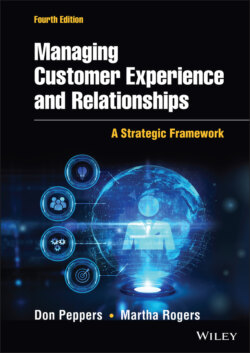Читать книгу Managing Customer Experience and Relationships - Don Peppers - Страница 23
LEARNING RELATIONSHIPS: THE CRUX OF BUILDING CUSTOMER VALUE
ОглавлениеThe basic strategy behind Learning Relationship (Quadrant IV in Exhibit 1.2) is that the enterprise gives a customer the opportunity to teach it what they want so the company can remember it, give it to them, and keep their business. The more the customer teaches the company, the better the company can provide exactly what the customer wants, and the more the customer has invested in the relationship. Ergo, the customer will more likely choose to continue dealing with the enterprise rather than spend the extra time and effort required to establish a similar relationship elsewhere.9
The Learning Relationship works like this: If you're my customer and I get you to talk to me, and I remember what you tell me, then I get smarter and smarter about you. I know something about you that my competitors don't know. So I can do things for you my competitors can't do, because they don't know you as well as I do. Before long, you can get something from me you can't get anywhere else, for any price. At the very least, you'd have to start all over somewhere else, but starting over is more costly than staying with me. As long as you like me and trust me to look out for your best interests, you're likely to do more of your business with me.
This happens every time a customer buys groceries by updating their online grocery list or adds a favorite movie to “My Stuff” on their favorite streaming provider. Even if a competitor were to establish exactly the same capabilities, a customer already involved in a Learning Relationship with an enterprise would have to spend time and energy—sometimes a lot of time and energy—teaching the competitor what the current enterprise already knows. This creates a significant switching cost for the customer, as the value of what the enterprise is providing continues to increase, partly as the result of the customer's own time and effort. The result is that the customer becomes more loyal to the enterprise because it is simply in the customer's own interest to do so. It is more worthwhile for the customer to remain loyal than to switch. As the relationship progresses, the customer's convenience increases, and the enterprise becomes more valuable to the customer, allowing the enterprise to protect its profit margin with the customer, often while reducing the cost of serving that customer.
Learning Relationships provide the basis for a completely different arena of competition, separate and distinct from traditional, product-based competition. An enterprise cannot prevent its competitor from offering a product or service that is perceived to be as good as its own offering. Once a competitor offers a similar product or service, the enterprise's own offering is reduced to commodity status. But enterprises that engage in collaborative Learning Relationships with individual customers gain a distinct competitive advantage because they know something about one customer that a competitor does not know. In a Learning Relationship, the enterprise learns about an individual customer through their transactions and interactions during the process of doing business. The customer, in turn, learns about the enterprise or the website through their successive purchase experiences and other interactions. Thus, in addition to an increase in customer loyalty, two other benefits come from Learning Relationships:
1 The customer learns more about their own preferences from each experience and from the firm's feedback, and is therefore able to shop, purchase, and handle some aspect of their life more efficiently and effectively than was possible prior to this relationship.
2 The enterprise learns more about its own strengths and weaknesses from each interaction and from the customer's feedback, and is therefore able to market, communicate, and handle some aspects of its own tactics or strategy more efficiently and effectively than was possible prior to the relationship.10
Cultivating Learning Relationships depends on an enterprise's capability to elicit and manage useful information about customers. Customers, whether they are consumers or other enterprises, do not want more choices. Customers simply want exactly what they want—when, where, and how they want it. And technology is now making it more and more possible for companies to give it to them, allowing enterprises to collect large amounts of data on individual customers' needs and then use that data to customize products and services for each customer—that is, to treat different customers differently.11 This ability to use customer information to offer a customer the most relevant product at the right price, at the right moment, is at the heart of the kind of customer experience that builds loyalty and share of customer.
Customers, whether they are consumers or other enterprises, do not want more choice. Customers simply want what they want, when, where, and how they want it.
One of the implications of this shift is an imperative to consider and manage the two ways customers create value for an enterprise. We've already said that a product focus tends to make companies think more about the value of a current transaction than the long-term value of the customer who is the company's partner in that transaction. But building Learning Relationships has value only to a company that links its own growth and future success to its ability to keep and grow customers, and therefore commits to building long-term relationships with customers. This means we find stronger commitments to customer trust, employee trust, meeting community responsibilities, and otherwise thinking about long-term, sustainable strategies. Companies that are in the business of building the value of the customer base are companies that understand the importance of balancing short-term and long-term success. We talk more about that in Chapters 6 and 11.
